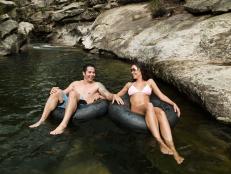This Couple Drove From China to Holland in a 1980s Land Rover
Rewards, risks and revelations on the road less traveled.

Elisabeth van der Kogel & Lagon van de Lagemaat

The truck careened violently down the mountain pass, spitting rocks from under its treads atop one of the most dangerous roads in the world. Its passengers had to get down, and fast.
Elisabeth van der Kogel and Lagon van de Lagemaat had been on the road for weeks. The Dutch couple had driven from Beijing to Tibet on what felt like an endless road. A day earlier, they had watched the sun rise nearly four miles high in the Tibetan sky. A few hours earlier, they saw the same orange glow at Everest Base Camp North Face. But now, with flashes of Mount Everest in the rearview, they were in a race against time. For days, they had been battling flu-like symptoms. And for days, they had pushed through the tell-tale signs of altitude sickness, driving and sleeping higher than most of the peaks in the U.S.
Miles ahead on the very same road, another Land Rover was kicking up rocks. There, stuffed onto a makeshift bed in the back, was their physician, Frits. Crippled by an intense case of altitude sickness, the nomadic doctor was finally succumbing to the intense heights of the Himalayas.
Earlier the day, the convoy had given its pressure suits and its physician to a group of tourists going up to Base Camp. Now, Frits was paying the price.
Together, the sick doctor and his chase cars were some of the first westerners to drive from China into Nepal in decades. The 12-Rover convoy had already traveled more than 6,000 miles on rubber treads, but if they wanted to make it back together, Frits needed to get to the only hospital in the region, more than 100 miles away—through razor-sharp turns, deadly drops, the Nepalese border and a civil war— in Kathmandu.
Strange Sagas on the Rocky Road From China
The 22,000-mile path that brought Team 6 to the Himalayas began three years earlier, when Lagon worked in a theater group in Haarlem, Holland. There, he met a group of explorers planning a global trip for good. For 8,000 euro, the explorers estimated, they could build a school in a place that needed one. And so, a few thousand euros at a time, the 12 teams raised funds to sponsor each leg of the epic voyage.

Elisabeth van der Kogel & Lagon van de Lagemaat
By 2004, the Rovers were on the road. In their wake, they’d leave a trail of miniature, plastic globes and dozens of newly built schools and orphanages in China, Nepal, India and Yemen—the fruits of their labor.
“We were going there to check on the buildings,” recalls Lagon, “to make sure they had really been built. We worked with companies and people to raise money for these schools and orphanages, and we drove to them with plastic globes to show the children where we were from.”
But reaching those buildings wasn’t always easy. To find them, they’d power through vast deserts, the world’s highest peaks, a spiderweb of travel laws and several war zones.
In Saudi Arabia, Team 6 needed a 24-hour police escort and a written request from the Dutch ambassador to pass. 172 police escorts tailed them through the desert, where they had just five days to cross Saudi sands—without stopping.

Elisabeth van der Kogel & Lagon van de Lagemaat
All of this took place in 2004, in a pre-smartphone world that was just beginning to enter the digital age. Then, much of the developed world was still transitioning from analog, and the remote regions between a pre-Olympics China and their home in Holland were lightyears away from reliable mobile communication. Often, the voyagers were reliant on expensive satellite technology for communication as they faced geologic and cultural obstacles in their quest to cross Eurasia.
“It was about a euro per word,” Lagon recalls, before sitting down at a weathered wooden table at their home in the French countryside. Elisabeth passes over a hot tea as the couple hovers together over the faded wood’s grain.
An ancient, blue Land Rover looms through a nearby window.
Before the tea can chill, a stack of printed photos appears in Lagon’s hands, and he glances at them as if he’s seeing an old friend for the first time in years.
A photo of a school room packed with children catches his eye. The story of Frits will have to wait.

Elisabeth van der Kogel & Lagon van de Lagemaat
“We were going from road block to road block in Nepal,” Lagon says. “But after the second one, the military began calling each other and telling themselves that crazy Dutch people were coming through. We were looking for a school in a village that we didn’t know the name of. We only knew the name of the school, and we had no idea where it was.”
After days of searching and questioning soldiers at checkpoints, the convoy found their school—in the middle of the Nepalese civil war. Team 6 distributed school supplies sent by sponsors, spent the night and woke up to a bombing 15 miles away.
As more photos fly through Lagon’s hands, the scope of their journey begins to unfold. Fingers fall over curious children in Tibet, campsites on the shores of the Yangtze River, and heartache in the slums of India.
“The outer villages of Bombay were heartbreaking,” the Dutchman recounts. “You hear about people living in cardboard boxes; but these are cardboard box villages four stories high. Every day, all the trash is dumped in front of them to sort out for food to eat. And it’s not a few hundred meters of this, I was riding for two hours in a cab through those villages to meet the trucks. Then, I snapped. I couldn’t stand seeing millions of people living like that.”
From Mumbai, the team loaded their trucks onto cargo ships bound for the Middle East, and made their way across the Arabian Peninsula, over the turtle-lined beaches of Oman, before eventually navigating to war-torn Yemen.
“In Yemen, it was still a Wild West,” says Lagon. “Everyone had a Kalashnikov.”
Team 6 would enter Yemen’s capital city of Sana’a trailed by armed contractors.
“They had a truck with a 70mm gun guarding us, because we were a real curiosity,” Lagon tells. “At the time, only about 500 real tourists a year went to Yemen—the rest were with aid groups or something like that.” Elisabeth nods in approval, then produces a curved knife from a weathered, leather sheath: a gift from the Arabian peninsula, where despite first appearances, the couple says locals were friendly and accommodating. Occasionally, they’d help push the Rovers through the sand, or guard the vehicles for hours at a time.

Elisabeth van der Kogel & Lagon van de Lagemaat
By this point, many miles and an ocean away from the tribulations in Tibet, Lagon says, the bizarre had become routine. “During the night, it was like images of Baghdad with crossfire over us. We didn’t know what was going on. The next night we woke up and realized it was a wedding from a tribe on one side of us to another on the opposite side. There are so many stories about those kinds of small adventures there are dozens of them.”
Looking for the Light
The journey sounds like a script from an action movie. In reality, the duo says there were days of peaceful driving through desolate landscapes, especially in rural Mongolia and China. The lessons learned from the roads there were more cerebral: In Mongolia, they don’t ride horses, they ride motorcycles. In China, people were building dams and bridges rock by rock, with lines of thousands handing stones up and over mountains one at a time. In Jordan, the crowded ruins of Petra palled in comparison to the remote roads already under their tires.
Elisabeth laughs as her partner tell tales of maintenance checks on the trucks. In Abu Dhabi, their filthy trucks cluttered a garage filled with Italian sports cars. Somewhere in western China, mechanics banged on the undercarriages with hammers to gauge the thickness of the steel. In the most isolated areas, children and adults clamored to sit inside of the trucks, the likes of which they hadn’t yet seen.
In the growing pile of photos, Elisabeth sifts for a snapshot that would be nearly impossible to capture now—a smiling traveler huddled beside a giant panda, legally.

Elisabeth van der Kogel & Lagon van de Lagemaat
In six months on the road, Elisabeth van der Kogel and Lagon va de Lagemaat gained a unique perspective on the world. They camped on the same sites that Lawrence of Arabia did. They stood on the monastery balconies featured in Seven Years in Tibet. And, they found smiling faces in all of the school buildings and orphanages their exploration group funded.
“When it was done,” Elisabeth says, “we didn’t know what to think.”
“It took a long time to absorb,” adds Lagon.
Nomads of Normandy
Today, the old Land Rover from Team 6 stands guard over the kitchen in the French countryside. Its engine fires daily, and its well-worn frame carries other travelers from across the globe to a secluded camping site on the farm.
Elisabeth and Lagon call their new home Safari Normandy. Here, they practice green living, host dozens of campers in canvas tents during the summer, and teach people how to build sustainable tiny houses. And, they have some advice for future travelers. “Just do it,” Lagon says. “Travel as light as possible. Buy good equipment. Don’t take food from home.”
As he steps away from the table, Lagon has a final word for travelers: “The world has never been a safer place to travel.”
As for Frits?
“We were detained at the border for five hours,” Lagon laughs. “He made it to Kathmandu before us, and we found him perfectly recovered sitting in a chair at a resort!”





























.jpg.rend.hgtvcom.231.174.suffix/1674758726773.jpeg)











